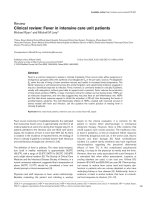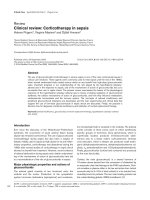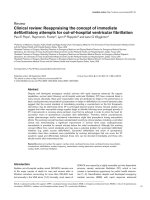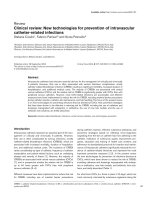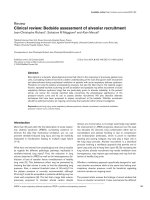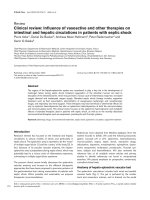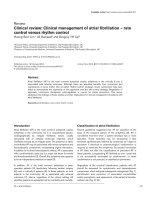Báo cáo khoa học: "Clinical review: Corticotherapy in sepsis" pot
Bạn đang xem bản rút gọn của tài liệu. Xem và tải ngay bản đầy đủ của tài liệu tại đây (345.74 KB, 8 trang )
122
ACTH = adrenocorticotrophic hormone; AVP = arginine vasopressin; CBG = cortisol-binding globulin; CRH = corticotrophin-releasing hormone;
IL = interleukin; NO = nitric oxide; Th = T helper; TNF = tumour necrosis factor.
Critical Care April 2004 Vol 8 No 2 Prigent et al.
Introduction
Ever since the discovery of the Waterhouse–Friderichsen
syndrome, the occurrence of acute adrenal failure during
sepsis has remained controversial. The use of glucocorticoids
(corticotherapy) during sepsis has also been a subject of
debate. Initially used in sepsis at high doses for its anti-inflam-
matory properties, corticotherapy was abandoned during the
1980s after several studies of corticotherapy in septic shock
showed no benefit from treatment. However, recent evidence
of adrenal dysfunction during sepsis and a better understand-
ing of the mechanisms of action of glucocorticoids have led
to a reconsideration of the role of glucocorticoids in sepsis.
Major physiologic properties and actions of
glucocorticoids
The adrenal gland consists of two functional units: the
medulla and the cortex. Production of the sympathetic
system hormones (adrenaline [epinephrine] and noradrena-
line [norepinephrine]) is localized in the medulla. The adrenal
cortex consists of three zones, each of which synthesizes
specific groups of hormones. Zona glomerulosa, which is
superficially located, produces mineralocorticoids (aldo-
sterone and, to a lesser extent, corticosterone); whereas
zona reticularis, which is deeper set, produces weak andro-
gens (dehydroepiandrosterone, dehydroepiandrosterone sul-
phate, ∆
4
-androstenedione and 11β-hydroxyandrostenedione).
Finally, glucocorticoids (cortisol and cortisone) are produced
by the zona fasciculata.
Cortisol, the main glucocorticoid, is a steroid hormone of
19 carbon atoms derived from the conversion of cholesterol by
an enzymatic chain that belongs to the P450 cytochrome. Corti-
sol circulates in plasma either in its free and active form (which
accounts only for 5–10% of total cortisol) or in its inactive form,
reversibly bound to proteins. The two main binding proteins are
the cortisol-binding globulin (CBG) and albumin [1].
Review
Clinical review: Corticotherapy in sepsis
Helene Prigent
1
, Virginie Maxime
2
and Djillali Annane
3
1
Senior Resident, Service de Réanimation Médicale, Hôpital Raymond Poincaré, Garches, France
2
Senior Resident, Service de Réanimation Médicale, Hôpital Raymond Poincaré, Garches, France
3
Director of the ICU, Service de Réanimation Médicale, Hôpital Raymond Poincaré, Garches, France
Correspondence: Djillali Annane,
Published online: 29 September 2003 Critical Care 2004, 8:122-129 (DOI 10.1186/cc2374)
This article is online at />© 2004 BioMed Central Ltd (Print ISSN 1364-8535; Online ISSN 1466-609X)
Abstract
The use of glucocorticoids (corticotherapy) in severe sepsis is one of the main controversial issues in
critical care medicine. These agents were commonly used to treat sepsis until the end of the 1980s,
when several randomized trials casted serious doubt on any benefit from high-dose glucocorticoids.
Later, important progress in our understanding of the role played by the hypothalamic–pituitary–
adrenal axis in the response to sepsis, and of the mechanisms of action of glucocorticoids led us to
reconsider their use in septic shock. The present review summarizes the basics of the physiological
response of the hypothalamic–pituitary–adrenal axis to stress, including regulation of glucocorticoid
synthesis, the cellular mechanisms of action of glucocorticoids, and how they influence metabolism,
cardiovascular homeostasis and the immune system. The concepts of adrenal insufficiency and
peripheral glucocorticoid resistance are developed, and the main experimental and clinical data that
support the use of low-dose glucocorticoids in septic shock are discussed. Finally, we propose a
decision tree for diagnosis of adrenal insufficiency and institution of cortisol replacement therapy.
Keywords adrenal insufficiency, glucorticoids, hormone replacement therapy, hypothalamic–pituitary–adrenal
axis, sepsis
123
Available online />Because of its lipophylic nature, cortisol enters the cells pas-
sively and binds to a soluble cytosolic receptor – glucocorti-
coid receptor type II – which in its inactive form is bound to
heat shock protein-90. The glucocorticoid-receptor complex
enters the nucleus and interacts directly with specific DNA
sites (glucocorticoid-responsive elements), exerting both
inhibitory and activating actions on transcription [2]. Study of
the effect of glucocorticoids on gene expression of mononu-
clear cells shows that glucocorticoids upregulate and down-
regulate up to 2000 genes that are involved in regulation of
the immune response [3].
Cortisol is metabolized by the liver (reduced and conjugated)
as well as by the kidney, where it is converted into its inactive
metabolite cortisone by the 11β-hydroxysteroid dehydroge-
nase. Steroids that possess a ketone group at position 11
have an affinity for both glucocorticoid and mineralocorticoid
receptors, which accounts for the weak mineralocorticoid
activity of glucocorticoids.
Regulation of glucocorticoid production
The production of glucocorticoids is regulated by the hypo-
thalamic–pituitary axis. Cortisol production and secretion is
stimulated mainly by the adrenocorticotrophic hormone
(ACTH). This peptide is comprises 39 amino acids and is
produced in the anterior pituitary. It is liberated by cleavage of
a large precursor, the pro-opiomelanocortin, which also liber-
ates other peptides (β-endorphin, lipotropin, melanocyte-stim-
ulating hormone). In the short term, ACTH stimulates cortisol
production and secretion (cortisol storage in adrenal glands
being low); in the longer term, ACTH also stimulates the syn-
thesis of enzymes that are involved in cortisol production, as
well as their cofactors and adrenal receptors for low-density
lipoprotein cholesterol. ACTH also stimulates the production
of adrenal androgens and, to a lesser extent, that of mineralo-
corticoids [1].
The half-life of ACTH is short and its action is fast because
cortisol concentration in adrenal veins rises only a few
minutes after ACTH secretion [4]. ACTH secretion is regu-
lated by several factors. The main stimulators of its produc-
tion are the corticotrophin-releasing hormone (CRH) and
arginine vasopressine (AVP), which are both secreted by the
hypothalamus. AVP stimulates ACTH secretion only weakly
but it strongly promotes CRH action. Catecholamines,
angiotensin II, serotonin and vasoactive intestinal peptide are
also known stimulators of ACTH secretion. Finally, some
inflammatory cytokines influence ACTH secretion, exerting
either a stimulatory action (IL-1, IL-2, IL-6, tumour necrosis
factor [TNF]-α) or an inhibitory one (transforming growth
factor-β) [4–6].
CRH is a 41-amino-acid peptide secreted by the hypothala-
mus. Liberated in the hypothalamic–pituitary portal system, it
stimulates the production and the secretion of pro-opiome-
lanocortin. Many factors influence CRH secretion. Adrenergic
agonists (noradrenaline) and serotonin stimulate its produc-
tion whereas substance P, opioids and γ-aminobutyric acid
inhibit it. Inflammation cytokines (IL-1, IL-2, IL-6, TNF-α) also
influence production of CRH [4,7].
Finally, glucocorticoids exert a negative feedback on the
hypothalamic–pituitary axis, inhibiting ACTH production as
well as pro-opiomelanocortin gene transcription, and CRH
and AVP production.
Secretion of the hypothalamic–pituitary axis hormones
(ACTH, CRH and AVP) follows a pulsatile course with a cir-
cadian rhythm. The amplitude of the secretory pulses varies
throughout the day and is greatest in the morning between 6
and 8
AM, rapidly decreasing until noon and decreasing more
slowly until midnight [1].
Main actions of glucocorticoids
Since the discovery of cortisol by Kendall and Reichstein in
1937, the actions of glucocorticoids have been progressively
identified and defined in many areas.
Metabolic effects
Glucocorticoids play a major role in glucose metabolism.
They stimulate liver gluconeogenesis and glycogenolysis,
promote the action of the other hormones that are involved in
gluconeogenesis (glucagon and adrenaline), and inhibit cellu-
lar uptake of glucose by inducing peripheral insulin resis-
tance. The main consequence of these actions is a rise in
blood glucose concentration [8]. Glucocorticoids also influ-
ence fat metabolism, activating lipolysis and inhibiting
glucose uptake by the adipocytes. They inhibit protein synthe-
sis and activate proteinolysis in muscles, liberating amino
acids that can serve as substrates for gluconeogenesis.
Finally, they are involved in bone and mineral metabolism,
activating osteoclasts, inhibiting osteoblasts, decreasing
intestinal calcium uptake and increasing calcium urinary
secretion by decreasing its renal reabsorption [1].
Immunological and anti-inflammatory effects
Immune cells present high-affinity receptors for glucocorti-
coids. Many effects of glucocorticoids on the immune and
inflammatory responses have been described in vitro but their
clinical relevance remains controversial. An anti-inflammatory
effect is clinically observed when the hormones are given at
supra-physiological doses. However, glucocorticoids influ-
ence the main mediators of the inflammatory response,
namely lymphocytes, natural killer lymphocytess, monocytes,
macrophages, eosinophils, neutrophils, mast cells and
basophils [9]. Glucocorticoid administration is followed by a
fall in circulating lymphocytes, which results from the passage
of lymphocytes from main circulation toward lymphoid organs
(e.g. spleen, adenopathies, thoracic canal). The opposite
effect is observed with granulocytes, which accumulate in
blood circulation, whereas neutrophil migration toward inflam-
matory sites is inhibited (resulting from decreased secretion
124
Critical Care April 2004 Vol 8 No 2 Prigent et al.
of chemokines), which contributes to a decreased local
inflammatory reaction. Macrophage secretion is inhibited by
the production of migration inhibitory factor [10]. Finally, glu-
cocorticoids stimulate eosinophil apoptosis [11].
Glucocorticoids are involved in the immune response by inhibit-
ing the production of IL-12 by macrophages and monocytes,
and therefore influencing lymphocyte differentiation by acting
on the Th1/Th2 balance. IL-12 is a strong stimulator of inter-
feron-γ synthesis and inhibitor of IL-4 secretion. Inhibition of
IL-12 secretion and of the expression of its receptors on T and
natural killer lymphocytes favours IL-4 production and lifts the
suppressive effects of IL-12 on Th2 activity. Th1 and Th2 lym-
phocytes are mutually inhibitory, and therefore the promotion of
Th2 activity and humoral immunity is associated with a sup-
pression of cellular immunity [9]. However, these in vitro obser-
vations must be confirmed in vivo. A recent study of cytokines
expressed by 40 patients with septic shock, 20 of whom were
treated with low doses of glucocorticoids, showed an increase
in IL-12 secretion and did not show an increase in Th2 differen-
tiation while under glucocorticoid treatment [12].
Glucocorticoids modulate the cytokine response observed
during inflammation (Table 1). On the cellular level, this action
is mediated by the inhibition of the production and of the
activity of proinflammatory cytokines (IL-1, IL-2, IL-3, IL-6,
interferon-γ, TNF-α), chemokines, eicosanoids, bradykinin and
migration inhibitory factor [5,10,13,14]. This inhibition results
both from the direct interaction between the glucocorticoid-
receptor complex and the glucocorticoid responsive elements
located on DNA, and from the inhibition of transcriptions
factors such as nuclear factor-κB (mediated by the inhibitory
factor IκB) and activator protein-1 [2]. Simultaneously, gluco-
corticoids stimulate the production of anti-inflammatory
factors such as IL-1 receptor agonist, the soluble TNF recep-
tor, IL-10 and transforming growth factor-β [15,16]. This anti-
inflammatory activity is completed by inhibition of the
production of cyclo-oxygenase-2 and of the inducible nitric
oxide (NO) synthase, which are key enzymes in inflammation.
Glucocorticoids also induce the production of lipocortin-1,
which in turn inhibits the synthesis of leucotrienes and of
phopholipase A
2
– an important enzyme that is involved in the
arachidonic acid cascade [4,17].
Cardiovascular effects
Glucocorticoids are involved in vascular reactivity. Indeed,
although hypertension is a common complication of corti-
cotherapy, hypotension is a key symptom of adrenal failure.
Blocking the effects of endogenous cortisol in animals results
in arterial hypotension, which seems secondary to an effect
on peripheral resistances, whereas cardiac output is unaf-
fected. This effect of cortisol appears independent of miner-
alocorticoid activity. Although the mechanisms of the vascular
effects are not fully understood, glucocorticoids modulate
vascular reactivity to angiotensin II and to catecholamines
(adrenaline and noradrenaline). The increase in transcription
and expression of glucocorticoid receptors might be one of
the mechanisms involved [18]. Glucocorticoids also modu-
late vascular permeability and decrease production of NO as
well as of other vasodilator factors [1,7].
Glucocorticoids and stress
The main role of the stress response is to maintain homeosta-
sis. The hypothalamic–pituitary axis, along with the adrenergic
and sympathetic nervous systems, are the main mediators of
the stress response.
Table 1
Main anti-inflammatory effects of glucocorticoids
Anti-inflammatory effect Details
Proinflammatory cytokine production Inhibition of IL-2, IL-3, IL-4(?), IL-5, IFN-γ, GM-CSF synthesis by T lymphocytes
Inhibition of IL-1, TNF-α, IL-6, IL-8, IL-12, MIF synthesis by macrophages/monocytes
Inhibition of IL-8 synthesis by neutrophils
Anti-inflammatory cytokine production Increase in IL-10, TGF-β, IL-1 receptor antagonist synthesis
Inflammatory cell migration Inhibition of chemokine production (MCP-1, IL-8, MIP-1α)
Stimulation of MIF and lipocortine-1 production by macrophages
Inflammation mediator expression Inhibition of soluble PLA
2
, inducible COX-2 and inducible NOS synthesis
Cell membrane markers expression Inhibition of CD14 expression on macrophages/monocytes
Inhibition of adhesion molecule expression (ICAM-1, ECAM-1, LFA-1, CD2) on endothelial cells
Apoptosis Activation of eosinophils and mature T lymphocyte apoptosis
COX, cylo-oxygenase; ECAM, endothelial cell adhesion molecule; GM-CSF, granulocyte–macrophage colony-stimulating factor; ICAM, intercellular
adhesion molecule; IFN, interferon; IL, interleukin; LFA, leucocyte function associated antigen; MCP, monocyte chemoattractant protein; MIF,
migration inhibitory factor; MIP, macrophage inflammatory peptide; NOS, nitric oxide synthase; PL, phospholipase; TGF, transforming growth
factor; TNF, tumour necrosis factor.
125
Almost all forms of stress (whether physical or psychological)
are followed by an immediate increase in ACTH secretion,
which is followed a few minutes later by an important rise in
cortisol blood levels [19]. Stress also results in a decrease in
CBG, leading to an increase in cortisol blood levels [20].
Moreover, free cortisol concentration can be enhanced at the
inflammatory site by an increase in neutrophil elastase activ-
ity, which will contribute to cleavage of cortisol and CBG.
Finally, cytokines may also increase the affinity of receptors
for glucocorticoids [15]. During stress adrenal hormone pro-
duction is characterized by a shift in the production of miner-
alocorticoids with a drop in aldosterone production, while
renin levels rise. However, the clinical significance and conse-
quences of this fall in mineralocorticoid production is
unknown, and mineralocorticoid treatment in sepsis remains
controversial. These events are associated with a loss of the
circadian rhythm of cortisol secretion secondary to an
increase in CRH and ACTH production, stimulated by inflam-
matory cytokines, vagal stimulation and reduction in cortisol
negative feedback [9,19].
As described above, a rise in glucocorticoid concentration
results in multiple effects with the aim of maintaining homeo-
stasis during stress. Metabolic effects, especially hypergly-
caemia, contribute to increasing energetic substrates during
a period that requires increased metabolism and transfer of
available glucose to insulin-independent cells (e.g. central
nervous system, inflammatory cells). Cardiovascular effects
occur to maintain normal vascular reactivity during the stress
period. Finally, glucocorticoids counteract almost every step
of the inflammatory cascade, modulating the immune
response. These different mechanisms are integrated in the
adaptive response to stress. Inflammatory cytokines (e.g.
TNF-α, IL-6, IL-1) acutely activate the hypothalamic–pituitary
axis, which reduces the inflammatory response; cortisol, in
turn, exerts a negative feedback on the hypothalamic–pitu-
itary axis, which allows the body to regulate the period in
which the immunosuppressive and catabolic effects of gluco-
corticoids are active [6]. However, over time, prolonged expo-
sure to cytokines might lead to an altered response of the
hypothalamic–pituitary axis. Thus, low levels of ACTH have
been described in patients presenting with severe sepsis or
systemic inflammatory response syndrome [14,21]. Likewise,
chronic increase in IL-6 can lead to a decrease in ACTH pro-
duction, while TNF-α may cause a reduction in adrenal func-
tion, CRH stimulation and ACTH production [7,22].
The concentration of circulating cortisol that is ‘normal’ for
the response to stress remains controversial. Various levels
have been proposed to define normal cortisol concentration,
ranging from 15 to 20 µg/dl [7,23–26]. These values are
based on the response observed after stimulation with exoge-
nous ACTH (250 µg) or with insulin-induced hypoglycaemia
in stable individuals. The relevance of these values in patients
subjected to acute stress remains to be demonstrated. A rise
in serum cortisol levels is observed in patients presenting
with severe sepsis as well as in patients undergoing surgery
[14,27–30]. Peak cortisol levels correlate with the severity of
infection. Thus, Rothwell and Lawler [31], measuring serum
cortisol levels on intensive care unit admission in
260 patients, observed significantly higher levels in patients
who did not survive. Serum cortisol level was an independent
predictive factor for outcome, reflecting the intensity of the
activation of the hypothalamic–pituitary axis as well as the
severity of the ‘stressful’ factor.
Stress response is associated with a rise in serum cortisol
levels, but the absolute value that represents an appropriate
response is not known. It probably varies according to the
underlying cause (depending on the importance of the surgi-
cal procedure, whether the patient presents with trauma or
severe sepsis) [19,32]. Moreover, a dynamic evaluation of
adrenal function is necessary in order to appreciate the
integrity of the hypothalamic–pituitary axis. This evaluation
relies on ACTH stimulation tests, which explore ACTH recep-
tor efficiency and the ability of adrenal cells to produce gluco-
corticoid. However, inducing hypoglycaemia with an insulin
test may be dangerous in unstable patients. The dynamic
response of serum cortisol levels after stimulation defines
whether the hypothalamic–pituitary axis is responding appro-
priately. The ‘normal’ value after stress exposure is not known,
but a rise of 9 µg/dl or more is commonly accepted as an
appropriate response [33,34].
Glucocorticoids and sepsis
The initial phase of sepsis is associated with intense inflam-
matory activity, secondary to the identification of infectious
components by the immune system. The major anti-inflamma-
tory role played by glucocorticoids naturally led to considera-
tion of their use in sepsis. The first evaluations of
corticotherapy in severe sepsis were done with high doses of
glucocorticoids and did not show any benefit on duration of
shock or on outcome [35,36]. A meta-analysis of nine
prospective randomized controlled studies [37] concluded
that glucocorticoids have no favourable effects on morbidity
and mortality in severe sepsis, and even suggested an
increased risk for superinfection-related death.
The emerging concept that transient adrenal failure repre-
sents an aggravating factor during sepsis and septic shock
led to reconsideration of the use of glucocorticoids in sepsis.
Numerous factors interfere with the hypothalamic–pituitary
axis response during sepsis. The presence of an underlying
pituitary or adrenal pathology can lead to an acute adrenal
failure, which can be triggered by sepsis. The use of specific
drugs can interfere with adrenal function either by inhibiting
the enzymes that are involved in cortisol synthesis (e.g. etomi-
date, ketokenazole) or by increasing cortisol metabolism
(phenytoin, phenobarbital) [19]. Finally, in postmortem
studies conducted in individuals who died from septic shock,
bilateral adrenal haemorrhages or necrosis was observed in
up to 30% of cases [14,19].
Available online />126
Several studies have shown that the frequency of adrenal
failure, defined as an inappropriate glucocorticoid response
during sepsis, depends largely on the threshold used
[14,21,28,34,38–41]. Dysfunction of the adrenal–hypothala-
mic–pituitary axis during severe illness can result from a com-
bination of different mechanisms, mainly adrenal failure and
peripheral resistance to glucocorticoids (Fig. 1).
Adrenal failure
Briegel and coworkers [42] studied adrenal function during
septic shock and after recovery in 20 patients. They showed
that 13 of the patients presented with adrenal failure, which
regressed after recovery from the sepsis. In 59 septic
patients, Marik and Zaloga [39] also found primary adrenal
failure in 25% and hypothalamic–pituitary axis failure in 17%
of cases. In a study conducted in 189 patients presenting
with severe sepsis [34], about 10% of patients had adrenal
failure (defined in that study as serum cortisol levels
<20µg/dl) whereas 50% of the patients had reversible
adrenal failure defined as high basal serum cortisol levels but
a blunted response to ACTH stimulation (increment in corti-
sol levels after 250 µg of ACTH of <9 µg/dl). The presence
of adrenal failure was associated with a significant increase
in mortality.
Peripheral resistance to glucorticoids
Inappropriate response to inflammation can be enhanced by
tissue resistance to glucocorticoids. In the 59 septic
patients they studied, Marik and Zaloga [39] found an inci-
dence of 19% of ACTH resistance. Several factors may be
involved and these probably interact: decreased access of
cortisol to the inflammatory site secondary to the reduction
in circulating CBG; modulation of local cortisol level by a
reduction in the cleavage of CBG–cortisol complex
(antielastase activity); reduction in the number and affinity of
glucocorticoid receptors, shown on lymphocytes treated
with different cytokines; and a rise in the conversion of corti-
sol in inactive cortisone by increased activity of the
11β-hydroxyseroid dehydrogenase stimulated by IL-2, IL-4
and IL-13. These different mechanisms can account for
decreased activity of glucocorticoids while serum cortisol
level is apparently appropriate.
Effects of low-dose corticotherapy during sepsis
Anti-inflammatory effects
Patients in septic shock treated with low doses of hydrocorti-
sone (300 mg/day over 5 days) exhibit a fall in temperature
and heart rate associated with a decrease in inflammatory
response (phospholipase A
2
and C-reactive protein), proin-
Critical Care April 2004 Vol 8 No 2 Prigent et al.
Figure 1
Activation of the hypothalamic–pituitary–adrenal axis during acute stress. Activating effects are shown with plain arrows, and inhibitory effects with
dotted arrows. The round symbols indicate the potential mechanisms that are involved in the axis dysfunction that occurs during sepsis either by
failure of production or by tissue resistance to glucocorticoids. ACTH, adrenocorticotrophic hormone; AVP, arginine vasopressine; CBG, cortisol-
binding globulin; CRH, corticotropin-releasing hormone; GRE, glucocorticoid responsive element; IFN, interferon; IL, interleukin; R, glucocorticoid
receptor; ANS, autonomic nervous system; Th, T helper; TNF, tumour necrosis factor.
127
flammatory cytokines and soluble adhesion complex, as well
as an increase in anti-inflammatory cytokines [17]. Keh and
coworkers [12] recently studied the effects of low-dose treat-
ment with hydrocortisone (240 mg/day after a bolus dose of
100 mg) in 40 patients in septic shock and demonstrated a
reduction in the production of inflammatory cytokines (IL-6
and IL-8), which was associated with a reduction in endothe-
lial and neutrophil activation. The production of IL-10 and
TNF-α soluble receptors (anti-inflammatory factors) was also
decreased. After withdrawal of treatment, a rebound effect
was observed in all of those mediators.
Cardiovascular effects
In healthy individuals, the local administration of lipopolysac-
charide (endotoxin) is followed by a reduction in the contrac-
tile response to noradrenaline, which is fully prevented by
pretreatment with hydrocortisone. Treatment with hydrocorti-
sone simultaneously with or just before administration of
lipopolysaccharide also prevents the occurrence of arterial
hypotension and the rise of both heart rate and plasma adren-
aline levels [43,44].
In numerous cases of septic shock, administration of low-
dose corticotherapy was followed by an improvement in
haemodynamic status and in response to vasopressor
drugs [17,26,45,46]. Administration of a single dose of
50 mg hydrocortisone in septic shock was followed by a
significant increase in blood pressure in patients treated
with catecholamines [47,48]. A multicentre study of 300
patients with septic shock comparing the effects of low-
dose treatment with hydrocortisone (50 mg every 6 hours)
plus fludrocortisone with those of placebo over 7 days [26]
showed a reduction in the duration of shock in treated
patients, who exhibited blunted responses to the ACTH
stimulation test. These effects were associated with a sig-
nificant improvement in survival in treated patients. Keh and
coworkers [12], in a double-blind study of the effects of low
doses of hydrocortisone (240 mg/day after a 100 mg bolus
) in 40 patients presenting with septic shock, also found an
improvement in haemodynamic status in treated patients,
with a reduction in the duration of shock and with recur-
rence of catecholamine dependency after withdrawal of glu-
cocorticoid treatment. The increase in mean arterial blood
pressure was associated with an increase in systemic resis-
tance and a reduction in cardiac index and heart rate, sug-
gesting that the effects of glucocorticoids mainly concern
peripheral vascular tone. Several mechanisms for the vascu-
lar effects of glucocorticoids might be involved. The inhibi-
tion of NO production – a vasodilator – may result from
direct inhibition of the inducible NO synthase by glucocorti-
coids [12]. Glucocorticoids might also increase the expres-
sion of catecholamine receptors, desensitized by the
negative feedback of high circulating levels of cate-
cholamines [49]. Finally, inhibition of the local production of
inflammation factors or of the direct stimulation by guanylate
cyclase might also be involved.
Effects on outcome
While studies concerning corticotherapy given at pharmalogi-
cal doses showed no benefit in terms of survival in patients
presenting with severe sepsis or septic shock, there are now
data favouring the use of low doses of hydrocortisone for at
least 5 days in patients with septic shock.
In 18 critically ill patients with adrenal failure, daily doses of
200 mg hydrocortisone significantly increased survival rate
compared with conventional treatment (90% versus 13%)
[23]. In a randomized, placebo-controlled, double-blind trial of
41 septic shock patients [46], 100 mg hydrocortisone every
8 hours for 5 days significantly improved 28-day survival com-
pared with placebo (63% versus 32%). These favourable
effects of low-dose glucocorticoids in septic shock were con-
firmed in a phase III trial [26]. However, in that study only
those patients with septic shock and a poor response to the
ACTH test benefited from glucocorticoids.
Therapeutic strategies
Adrenal failure can contribute to haemodynamic instability
and can perpetuate inflammation, and should therefore be
sought out in patients presenting with severe sepsis. Haemo-
dynamic instability, high dependency on catecholamines
despite control of infection, and occurrence of hypoglycaemia
or of hypereosinophilia should lead to suspicion of adrenal
failure. Basal serum cortisol levels of 15 µg/dl or less indicate
adrenal insufficiency [24,26]. When cortisol levels are greater
than 15 µg/dl, an ACTH stimulation test is required to rule out
adrenal insufficiency. An increment of 9 µg/dl or less strongly
suggests adrenal failure. Finally, an increase in cortisol levels
in excess of 9 µg/dl when the basal level is greater than
34 µg/dl suggests tissue resistance to glucocorticoid (Fig. 2).
The presence of adrenal failure requires prompt initiation of
replacement therapy with low doses of corticosteroids.
Replacement treatment with hydrocortisone (200–300 mg/day)
can be combined with 9α-fludrocortisone (50 µg/day) and
administered for 7 days in order to improve haemodynamic
status and response to vasopressor treatment, allowing
reduction in the duration of shock and improvements in short-
term and long-term survival. The ongoing Corticotherapy for
Septic Shock (CORTICUS) phase III trial, which is evaluating
hydrocortisone alone in septic shock, may help in deciding
whether to combine hydrocortisone with fludrocortisone.
Given the high frequency of adrenal dysfunction in septic
shock, replacement therapy should be started immediately
after the ACTH test is done, and be continued only in
patients with adrenal failure.
Further studies are needed to better identify adrenal failure in
septic shock. These studies should compare the low dose
(1 µg) ACTH test with the traditional 250 µg ACTH test,
using the metopirone test or induced hypoglycaemia as ‘gold
standards’ for the diagnosis of adrenal failure.
Available online />128
Conclusion
Adrenal dysfunction is commonly observed in severely ill
patients, especially in sepsis, and can increase morbidity and
mortality. The diagnosis of adrenal failure in the critically ill
remains a challenge and its criteria need to be improved.
While the use of high-dose corticoid treatment in sepsis is
not justified, replacement therapy by glucocorticoids can
improve outcomes in patients in septic shock. Detecting and
treating adrenal failure during severe sepsis or septic shock
seem bound to become a major part in the management of
the critically ill.
Competing interests
None declared.
References
1. Orth DN, Kovacs WJ, DeBold CR: The Adrenal Cortex. In
Williams Textbook of Endocrinology. Edited by Wilson JD, Foster
DW. Philadelphia: W.B. Saunders Company; 1992:489-531.
2. Almawi WY: Molecular mechanisms of glucocorticoid effects.
Mod Asp Immunobiol 2001, 2:78-82.
3. Galon J, Franchimont D, Hiroi N, Frey G, Boettner A, Ehrhart-
Bornstein M, O’Shea JJ, Chrousos GP, Bornstein SR: Gene pro-
filing reveals unknown enhancing and suppressive actions of
glucocorticoids on immune cells. FASEB J 2002, 16:61-71.
4. Chrousos GP: The hypothalamic-pituitary-adrenal axis and
immune-mediated inflammation. N Engl J Med 1995, 332:
1351-1362.
5. Cavaillon JM: Action of glucocorticoids in the inflammatory
cascade [in French]. Réanim Urgences 2000, 9:605-612.
6. Tsigos C, Chrousos GP: Hypothalamic-pituitary-adrenal axis,
neuroendocrine factors and stress. J Psychosom Res 2002,
53:865-871.
7. Marik PE, Zaloga GP: Adrenal insufficiency in the critically ill: a
new look at an old problem. Chest 2002, 122:1784-1796.
8. Pilkis SJ, Granner DK: Molecular physiology of the regulation
of hepatic gluconeogenesis and glycolysis. Annu Rev Physiol
1992, 54:885-909.
9. Chrousos GP: The stress response and immune function: clin-
ical implications. The 1999 Novera H. Spector Lecture. In
Neuroimmunomodulation. Perspectives at the New Millennium.
Edited by Conti A, Maestroni JM, McCann SM, Sternberg EM,
Lipton JM, Smith CC. New York: Ann NY Acad Sci; 2000:38-67.
10. Beishuizen A, Thijs LG, Haanen C, Vermes I: Macrophage migra-
tion inhibitory factor and hypothalamo-pituitary-adrenal func-
tion during critical illness. J Clin Endocrinol Metab 2001, 86:
2811-2816.
11. Beishuizen A, Vermes I, Hylkema BS, Haanen C: Relative
eosinophilia and functional adrenal insufficiency in critically ill
patients. Lancet 1999, 353:1675-1676.
12. Keh D, Boehnke T, Weber-Cartens S, Schulz C, Ahlers O,
Bercker S, Volk HD, Doecke WD, Falke KJ, Gerlach H: Immuno-
logic and hemodynamic effects of ‘low-dose’ hydrocortisone
in septic shock: a double-blind, randomized, placebo-con-
trolled, crossover study. Am J Respir Crit Care Med 2003, 167:
512-520.
13. Beishuizen A, Thijs LG: Endotoxin and the hypothalamo-pitu-
itary-adrenal (HPA) axis. J Endotoxin Res 2003, 9:3-24.
14. Soni A, Pepper GM, Wyrwinski PM, Ramirez NE, Simon R, Pina T,
Gruenspan H, Vaca CE: Adrenal insufficiency occurring during
septic shock: incidence, outcome, and relationship to periph-
eral cytokine levels. Am J Med 1995, 98:266-271.
15. Franchimont D, Martens H, Hagelstein MT, Louis E, Dewe W,
Chrousos GP, Belaiche J, Geenen V: Tumor necrosis factor
alpha decreases, and interleukin-10 increases, the sensitivity
of human monocytes to dexamethasone: potential regulation
of the glucocorticoid receptor. J Clin Endocrinol Metab 1999,
84:2834-2839.
16. Muller B, Peri G, Doni A, Perruchoud AP, Landmann R, Pasqualini
F, Mantovani A: High circulating levels of the IL-1 type II decoy
receptor in critically ill patients with sepsis: association of
high decoy receptor levels with glucocorticoid administration.
J Leukoc Biol 2002, 72:643-649.
17. Briegel J, Kellermann W, Forst H, Haller M, Bittl M, Hoffmann GE,
Buchler M, Uhl W, Peter K: Low-dose hydrocortisone infusion
attenuates the systemic inflammatory response syndrome.
The Phospholipase A2 Study Group. Clin Invest 1994, 72:782-
787.
18. Annane D, Bellissant E: Impact of corticosteroids on the vascu-
lar response to catecholamines in septic shock. Réanimation
2002, 11:111-116.
19. Lamberts SW, Bruining HA, de Jong FH: Corticosteroid therapy
in severe illness. N Engl J Med 1997, 337:1285-1292.
Critical Care April 2004 Vol 8 No 2 Prigent et al.
Figure 2
Strategy for detection and treatment of adrenal failure during sepsis. ACTH, adrenocorticotrophic hormone.
Severe sepsis / Septic Shock
Cortisol plasma levels
Cortisol ≤15 µg/dl Cortisol > 15 µg
/dl
Adrenal failure
ACTH stimulation test
Replacement
therapy
Cortisol rise ≤9 µg/dl Cortisol rise > 9 µg
/dl
15 µg/dl < Cortisol ≤ 34 µg/dl Cortisol > 34 µg
/dl
Adrenal failure No adrenal failure
Tissue resistance
to glucocorticoids?
Replacement
therap
y
No treatment
Replacement
Therap
y
?
129
Available online />20. Beishuizen A, Thijs LG, Vermes I: Patterns of corticosteroid-
binding globulin and the free cortisol index during septic
shock and multitrauma. Intensive Care Med 2001, 27:1584-
1591.
21. Schroeder S, Wichers M, Klingmuller D, Hofer M, Lehmann LE,
von Spiegel T, Hering R, Putensen C, Hoeft A, Stuber F: The
hypothalamic-pituitary-adrenal axis of patients with severe
sepsis: altered response to corticotropin-releasing hormone.
Crit Care Med 2001, 29:310-316.
22. Mastorakos G, Chrousos GP, Weber JS: Recombinant inter-
leukin-6 activates the hypothalamic-pituitary-adrenal axis in
humans. J Clin Endocrinol Metab 1993, 77:1690-1694.
23. McKee JI, Finlay WE: Cortisol replacement in severely stressed
patients [letter]. Lancet 1983, 1:484.
24. Cooper MS, Stewart PM: Corticosteroid insufficiency in acutely
ill patients. N Engl J Med 2003, 348:727-734.
25. Streeten DH: What test for hypothalamic-pituitary-adrenocorti-
cal insufficiency? Lancet 1999, 354:179-180.
26. Annane D, Sebille V, Charpentier C, Bollaert PE, Francois B,
Korach JM, Capellier G, Cohen Y, Azoulay E, Troche G, Chaumet-
Riffaut P, Bellissant E: Effect of treatment with low doses of
hydrocortisone and fludrocortisone on mortality in patients
with septic shock. JAMA 2002, 288:862-871.
27. Jurney TH, Cockrell JL Jr, Lindberg JS, Lamiell JM, Wade CE:
Spectrum of serum cortisol response to ACTH in ICU
patients. Correlation with degree of illness and mortality.
Chest 1987, 92:292-295.
28. Loisa P, Rinne T, Kaukinen S: Adrenocortical function and mul-
tiple organ failure in severe sepsis. Acta Anaesthesiol Scand
2002, 46:145-151.
29. Span LF, Hermus AR, Bartelink AK, Hoitsma AJ, Gimbrere JS,
Smals AG, Kloppenborg PW: Adrenocortical function: an indi-
cator of severity of disease and survival in chronic critically ill
patients. Intensive Care Med 1992, 18:93-96.
30. Schein RM, Sprung CL, Marcial E, Napolitano L, Chernow B:
Plasma cortisol levels in patients with septic shock. Crit Care
Med 1990, 18:259-263.
31. Rothwell PM, Lawler PG: Prediction of outcome in intensive
care patients using endocrine parameters. Crit Care Med
1995, 23:78-83.
32. Chernow B, Alexander HR, Smallridge RC, Thompson WR, Cook
D, Beardsley D, Fink MP, Lake CR, Fletcher JR: Hormonal
responses to graded surgical stress. Arch Intern Med 1987,
147:1273-1278.
33. Rothwell PM, Udwadia ZF, Lawler PG: Cortisol response to cor-
ticotropin and survival in septic shock. Lancet 1991, 337:582-
583.
34. Annane D, Sebille V, Troche G, Raphael JC, Gajdos P, Bellissant
E: A 3-level prognostic classification in septic shock based on
cortisol levels and cortisol response to corticotropin. JAMA
2000, 283:1038-1045.
35. Anonymous: Effect of high-dose glucocorticoid therapy on
mortality in patients with clinical signs of systemic sepsis. The
Veterans Administration Systemic Sepsis Cooperative Study
Group. N Engl J Med 1987, 317:659-665.
36. Bone RC, Fisher CJ Jr, Clemmer TP, Slotman GJ, Metz CA, Balk
RA: A controlled clinical trial of high-dose methylprednisolone
in the treatment of severe sepsis and septic shock. N Engl J
Med 1987, 317:653-658.
37. Cronin L, Cook DJ, Carlet J, Heyland DK, King D, Lansang MA,
Fisher CJ Jr: Corticosteroid treatment for sepsis: a critical
appraisal and meta-analysis of the literature. Crit Care Med
1995, 23:1430-1439.
38. Annane D, Raphael JC, Gajdos P: Are endogenous glucocorti-
coid levels adequate in septic shock? Intensive Care Med
1996, 22:711-712.
39. Marik PE, Zaloga GP: Adrenal insufficiency during septic
shock. Crit Care Med 2003, 31:141-145.
40. Moran JL, Chapman MJ, O’Fathartaigh MS, Peisach AR, Pannall
PR, Leppard P: Hypocortisolaemia and adrenocortical respon-
siveness at onset of septic shock. Intensive Care Med 1994,
20:489-495.
41. Rothwell PM, Udwadia ZF, Jackson EA, Lawler PJ: Plasma corti-
sol levels in patients with septic shock. Crit Care Med 1991,
19:589-590.
42. Briegel J, Schelling G, Haller M, Mraz W, Forst H, Peter K: A
comparison of the adrenocortical response during septic
shock and after complete recovery. Intensive Care Med 1996,
22:894-899.
43. Barber AE, Coyle SM, Marano MA, Fischer E, Calvano SE, Fong
Y, Moldawer LL, Lowry SF: Glucocorticoid therapy alters hor-
monal and cytokine responses to endotoxin in man. J Immunol
1993, 150:1999-2006.
44. Bhagat K, Collier J, Vallance P: Local venous responses to
endotoxin in humans. Circulation 1996, 94:490-497.
45. Briegel J, Forst H, Haller M, Schelling G, Kilger E, Kuprat G,
Hemmer B, Hummel T, Lenhart A, Heyduck M, Stoll C, Peter K:
Stress doses of hydrocortisone reverse hyperdynamic septic
shock: a prospective, randomized, double-blind, single-center
study. Crit Care Med 1999, 27:723-732.
46. Bollaert PE, Charpentier C, Levy B, Debouverie M, Audibert G,
Larcan A: Reversal of late septic shock with supraphysiologic
doses of hydrocortisone. Crit Care Med 1998, 26:645-650.
47. Bellissant E, Annane D: Effect of hydrocortisone on phenyle-
phrine: mean arterial pressure dose-response relationship in
septic shock. Clin Pharmacol Ther 2000, 68:293-303.
48. Annane D, Bellissant E, Sebille V, Lesieur O, Mathieu B, Raphael
JC, Gajdos P: Impaired pressor sensitivity to noradrenaline in
septic shock patients with and without impaired adrenal func-
tion reserve. Br J Clin Pharmacol 1998, 46:589-597.
49. Hotchkiss RS, Karl IE: The pathophysiology and treatment of
sepsis. N Engl J Med 2003, 348:138-150.
